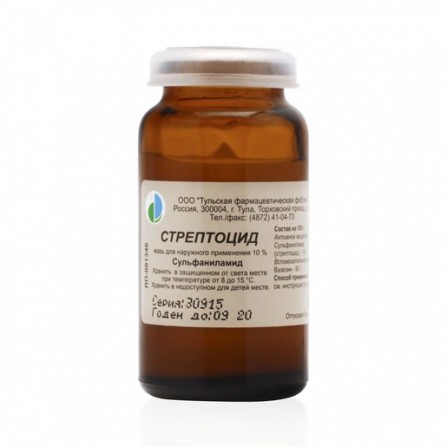Streptocide ointment 10% 25g
Condition: New product
997 Items
Rating:
Be the first to write a review!

More info
Active ingredients
Sulfanilamide
Release form
Ointment
Composition
Sulfanilamide 10 g
Pharmacological effect
Antibacterial agent of a broad spectrum. Sulfanilamide (streptocid) is one of the first representatives of chemotherapeutic agents of the sulfonamide group. It has a bacteriostatic effect. The mechanism of action is due to competitive antagonism with PABK and competitive inhibition of the enzyme dihydropteroate synthetase. This leads to disruption of the synthesis of dihydrofolate and then tetrahydrofolic acid and as a result - to disruption synthesis of nucleic kislot.Sulfanilamid active against Gram-positive and Gram-negative cocci, Escherichia coli, Shigella spp, Vibrio cholerae, Haemophilus influenzae, Clostridium spp, Bacillus anthracis,.. Corynebacterium diphtheriae, Yersinia pestis, as well as for Chlamydia spp., Actinomyces spp., Toxoplasma gondii.
Indications
Infectious and inflammatory diseases caused by microorganisms susceptible to sulfanilamide, including tonsillitis, erysipelas, cystitis, pyelitis, enterocolitis, infectious diseases of the skin and mucous membranes.
Contraindications
Severe renal failure, blood diseases, glucose-6-phosphate dehydrogenase deficiency, nephrosis, nephritis, acute porphyria, thyrotoxicosis, I and II trimesters of pregnancy, lactation, increased sensitivity to sulfanilamides.
Use during pregnancy and lactation
It is contraindicated for use in the I and II trimesters of pregnancy and lactation.
Dosage and administration
Inside adults - 500 mg-1 g 5-6 times / day; children under 1 year old - 50-100 mg, from 2 to 5 years old - 200-300 mg, from 6 to 12 years old - 300-500 mg per dose. Maximum doses for adults when administered orally: single 2 g, daily - 7 g . When applied topically applied to the affected skin and mucous membranes.
Side effects
On the part of the digestive system: nausea, vomiting, diarrhea. From the hematopoietic system: rarely - eosinophilia, thrombocytopenia, leukopenia, hypoprothrombinemia, agranulocytosis. From the CNS and peripheral nervous system: in isolated cases - visual impairment, headache, dizziness, peripheral nerves, peripheral nervous system, peripheral nervous system, dizziness, peripheral nervous system; , ataxia. Others: skin allergic reactions; rarely, nephrotoxic reactions (most likely in patients with impaired renal function); In isolated cases - hypothyroidism.
special instructions
Use with caution in patients with impaired renal function.During the period of treatment, it is necessary to increase the amount of fluid consumed. If hypersensitivity reactions occur, treatment should be stopped. For long-term treatment, systematic monitoring of the blood picture, kidney and liver function is recommended.


